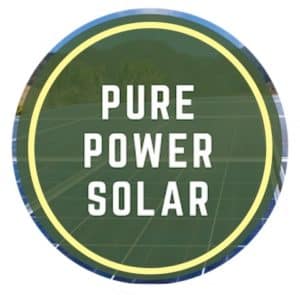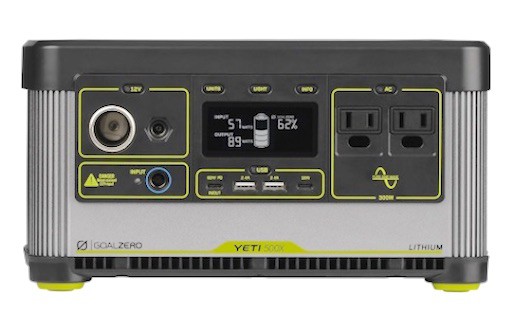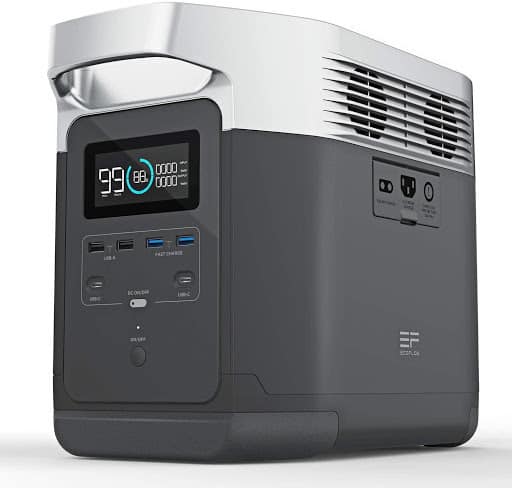Using a CPAP machine, solar energy stored in power stations or solar generators is an exceptionally reliable backup.
Whether you have occasional power outages or spend time on outdoor recreational activities like camping, the right solar generator can maintain your CPAP machine’s power requirements for days on end.
The following solar generators are excellent for use with CPAP machines.
With CPAP machines, people with sleep apnea can sleep comfortably
A good solar generator for a CPAP machine should generally have three key features. Once these features are present then they should serve your machine well and should pass for great functionality.
Pure Sine Wave Technology
CPAP machines are sensitive medical devices and using them with an inverter that produces modified sine waves is not advisable. Given that CPAP machines are also used for medical emergencies, pure sine waves are much preferable.
Battery Management System (BMS)
Due to numerous factors that are clearly beyond our control, we can neither guarantee stable current, voltage nor temperature. It is then quintessential to use a solar generator that has a BMS that offers short circuit protection, voltage control, temperature regulation, and current control.
Display and Battery Capacity
Solar generators must offer the capacity that they claim. This is important to help you truly enjoy its functionality.
An LCD display would also prevent you from running out of battery at a crucial time, as you are prepared ahead for the next recharge, This is very important on a camping trip, for a recreational vehicle, or another outdoor usage.
Other Features
These features are fairly forgivable, and slight variations just below these standards should still pass for a good solar generator.
One of such is that a good solar generator for a CPAP device should operate at an optimal temperature range of 40 F to 104 F (0 C – 40 C), you do not want your solar generator overheating while your CPAP device is in use.
Also, a good solar generator for CPAP use should have a good battery cycle. If you use a CPAP device regularly, it is highly unlikely that you would not recharge once or twice every week.
If the solar generator has a battery with a lifecycle of fewer than 500 charges, then it is not a good buy. Preferably, 1000 charges and above is a good one.
Note that solar generators vary from product to product and all solar generators DO NOT have the same features, but we have not compromised on the standard for the three key features a good solar generator for a CPAP device must-have.
The other two features are quite forgivable. All five solar generators on this list have the three key features needed for using a CPAP machine, and one or two other features have been forgiven. It is also important to note that this article is tailored to CPAP machines and a solar generator.

It doesn’t make this list appropriate and inclusive for other purposes. So, here are the top four solar generators for use with CPAP machines.
Similar: Top 15 Best Solar Generators for Camping (Small to Large)
1. ROCKPALS 500
The Rockpals comes with two variants. Both variants will be reviewed side by side. These power stations use an in-built 540Wh and 520Wh lithium batteries.
Far better than conventional batteries, both Rockpals use a lithium battery. You do not need to worry about self-discharge; they have little or no self-discharge as compared to other battery types.
CPAP USAGE
Sleeping well in a camping activity is just as important as the camping itself.
Both power stations are capable of emergency sources of power for your CPAP machine while you enjoy your sleep (the 540Wh generator works just well if your CPAP machine is less than 100W while the 520Wh can work with CPAP machines of up to 120W).
Using any variant of the Rockpals 500 is safe as they only produce pure sine waves which is important for the safety of your CPAP machine. Also, an in-built BMS ensures circuit protection. You should be sure of a temperature range below 65°C and 40°C. for the 540W and 520W variants, respectively.
OTHER FEATURES
Display and Accessibility
The battery life status display also ensures for better maintenance. Both solar generators also give you an alarm beep when your battery status runs at 10% and below prepares you for the worst. A backup should be a backup, and at that, it could prove frustrating to ‘suddenly’ experience the backing out of your backup, sometimes a gentle reminder will do.
Multi-Purpose Power Station
Apart from working with your CPAP, they can charge your multiple devices such as phones up to 40 times. They can also power a mini cooler or a mini-fridge to keep your food and drinks cool.
Super Bright LED Flashlight
If you love to sleep with the lights on, the LED flashlight uses a meager 1W to 4W meaning it can last for up to 100 hours, that is, 4 days of uninterrupted lighting when fully charged. You can also reduce or increase the brightness and intensity of the LED flashlight on both generators. The flashlight makes it a good option for outdoor users
Durability
The in-built batteries are rechargeable, the 540Wh variant has a rechargeable life cycle of up of 500 times, which the 520Wh variant has a life cycle of up to 1000 times. Both power stations are very efficient.
Proper use should ensure 3 to 5 years of optimum use at the least beyond the 2-year warranty. Like any other gadget or device, routine maintenance is necessary, and you should ensure that you regularly clean the power station(s) to avoid dust, and immediately clean up in the case of a water spills.
Quick and Flexible Charging
A 100W Rockpals Solar Panel can be used to charge both solar generators, you may even charge in your car with a 12V car charger or with a simple wall socket of 110V, 90W AC Adapter.
With the 540Wh variant, any means of charging usually takes around 6 to 7 hours.
The 520Wh variant takes an hour longer or two to completely recharge, using a 12V car charge or a 110V wall outlet takes around 7 to 8 hours, while a solar panel (6A max) should fully charge this variant in 8 to 9 hours.
For better efficiency, do not use your power station to power or charge any device while you are also charging it, it is best to perform only one of these at a time. Do not charge any of the power stations with your car, when not in use.
Charging the power station with your car cigarette lighter is only appropriate when your car engine is started and in use, to avoid power loss of your car battery.
You can review the 540Wh and 520Wh versions of the Rockpals 500 in my article here: Rockpals 500 Review (In-Depth) – Features, Specs, and More. This goes over the similarities and differences of the first two generations of the Rockpals 500, but there is a newer model that I’ve reviewed myself below.
Check out the newest (3rd generation) version of the Rockpals 500, called the Rockpower 500, here: Rockpals Rockpower 500 Review (Testing, Pricing, and More).
2. JACKERY EXPLORER 500
CPAP USAGE
The Jackery Explorer 500 is a great option for CPAP, especially for outdoor use, as they are very portable. At 13.2 lbs., you can carry them almost effortlessly and at a dimension of 13.11in. by 9.17in. by 11.14in., you can even put them in your camping bag.
A very grippy handle is present on the top of the power station for easy carriage. Considering the fact that the Jackery Explorer 500 holds a 518Wh battery and 500W inverter, its total weight of under 14 lbs. is simply meager.
It is compatible with 12V-30V CPAP machines and can power your CPAP machine for a 32-hour period (if that’s all you use it for), if you sleep around 4 hours daily, it should serve you for a few days without a recharge. The Jackery 500 can power up to 3 CPAP simultaneously (for shorter durations) as it has 3 separate DC output ports.
There is an LCD display screen on the power back that allows you to monitor the charge and discharge rates, it also displays the battery status; this is important used outdoors to help you monitor your battery and when you need to charge, which can be very essential during camping trips.
OTHER FEATURES
Battery Capacity and Charging
The Explorer uses a lithium (Li-ion) battery with a 1000W power for continuous use and a 1000W peak surge, 518Wh (21.6V, 46.4Ah). The cycle of this battery is 500 cycles before reducing to 80% efficiency.
It also comes with an in-built MPPT charge controller for faster and efficient solar charging. The battery management system provides short circuit protection and voltage regulation & control.
Full charge time using two SolarSaga 100W panels takes around 8 hrs, and the adapter cable to be used has already been included in the pack, and with a single 100W, it recharges fully in 17 hours. An AC car charger of 12V can also be used to charge the Explorer in 14 hrs. Using an AC wall outlet takes around 7 hrs.
Utility and Display
The Explorer is packed with a powerful in-built LED flashlight (which has a normal mode and SOS modes). Its 3 AC outlets use pure sine waves which are safer and protects your sensitive device(s) from damage or current fluctuations.
With no fumes, discharge, or emissions, the power station is outdoor-friendly. It also has a very welcoming display that shows you all the battery information you need.
Safety
This solar generator is just as safe as it can be. Pure sine waves are used rather than modified sine waves for the overall safety of electrical appliances.
With 2 BMSs, more and more safety is guaranteed, over temperature, voltage, and current fluctuations as well as circuit protection. When the solar generator is not in use for about 12 hours, it automatically shuts down, it does the same thing is the power draw is below the 10W mark for the same amount of time.
Similar: Goal Zero Vs. Inergy – Solar Generator Enterprise Match Up
3. GOAL ZERO YETI 500X
CPAP USAGE
The Yeti 500X is a good option for many reasons. CPAP machine usage requires a level of safety assurances which is what solar generators like Yeti 500X that operate on pure sine waves have to offer.
It powers heavy-duty CPAP machines for around 10 hours. At under 13 lbs, it is very easy to carry. It also has respectively faster charging times in comparison to other products in this category, average charging time using any of the three available charging methods take about 6 hours.
OTHER FEATURES
Battery Capacity and Fast Charging Output
Its lithium battery capacity is 505Wh (10.8V, 46.8Ah) which can power a range of devices such as cameras, laptops, tablets, and smartphones. It is equipped with fast charging features that ensure a high-speed charge via a USB-C power delivery port.
It also features an MPPT charge controller, which is very important for outdoor use and to get the best charging efficiency rate from solar energy. The battery life cycle is at 500 charges and it has a shelf life of 3 months, meaning you have to recharge it every 3 months to prevent the battery from damage.
It has a custom 60-W USB-C power delivery port that turns on in the click of a button; this is very effective for power-hungry devices. The Yeti 500X also has an 18-W USB-C port that enhances faster charging for lesser power-hungry devices. Its battery can power a portable fridge with the USB-C PD.
Charging
The Yeti 500X, much like most Yeti series, have fairly efficient charging rates. It can be charged via 3 means: a solar panel, an AC wall adapter, and a car charger.
Using a Boulder 100 solar panel fully charges the solar generators in about 8 hours, using a Boulder 200 can be much faster to recharge, at just under 4 hours. Charging via an AC wall charger will recharge the system in 8 hours and a car charger recharges it fully in 5 hours.
Portability
At 12.9 lbs, it is one of the lightest solar generators in this power category, if not the lightest. With a dimension of 7.5 in by 11.25 in by 5.8 in, it is very handy and easy to carry. It is designed such that the handle is easy to hold.
Output
It comes with numerous ports available to power devices.
A regulated 5V USB port (12W max), a regulated USB-C port (18W max), a regulated 5-20V USB-C Power Delivery port (60W max), a 12V 6mm port (120W max), a 12V car port (120W max), and a 120V AC inverter (300W and a peak surge of 1200W). All outputs give pure sine waves.
These ports can work simultaneously, in a single purpose use, it can charge a camera 70 times, a smartphone up to 40 times, a tablet 10 times, and pellet grill for up to 9 hours. If you intend to use it indoors, it could power your TV for up to 3 hours.
Read The Full Yeti 500X Review Here
4. ECOFLOW DELTA 1300
CPAP USAGE
The EcoFlow Delta 1300 is a good solar generator for CPAP machines. The last one on this list and the best in some respects, it powers a CPAP for about 20 hours.
It features a 1800W AC outlet with 3300W peak power. In addition, these outlets use pure sine waves to keep your devices safe.
The Delta 1300 can power up 13 devices simultaneously, while it is highly unlikely that you would need to power 12 other devices while using a CPAP, it can be useful for three to four other devices, such as a bed-side fan or lighting.
Similar: How Long Will a Solar Generator Last?
OTHER FEATURES
Battery Capacity
A lithium battery capacity of 1260Wh hours is designed with a 1800W inverter that has a peak surge of 3300W. The Delta 1300 can be charged and discharged (used) at the same time.
This lithium battery can power a large freezer for up to 15 hours, a coffeemaker to make 50 cups, a toaster or grill for about 2 hours and a hairdryer for about 3 hours.
Charging
The DELTA 1300 charges at a ridiculous rate. The three conventional means of recharging solar generators are available, and, in just an hour, the Delta 1300 goes for 0% to 80%, just one hour from an AC wall outlet, in another hour, the solar generator is fully charged, that’s 2 hours via an AC wall outlet.
This is about 7-10 times the rate of any other solar generator in this category. This ‘X-Stream’ superfast technology has been patented by EcoFlow.
The Delta 1300 fully recharges in 10 hours using a 12V or a 24V car charger port. Using two or more EcoFlow 110W solar panels can recharge the device in about 4-12 hours, depending on the number of panels used, the fastest rate is gotten using 4 of 110W solar panels, which recharges the Delta 1300 in 4 hours.
Durability
With an already amazing charging, you would have thought you would not need a lengthy warranty, well the Delta 1300 has a 48-month warranty, that is, EcoFlow has got you covered for 2 years. Considering the super-fast charging feature, its whopping ability to simultaneously power 13 devices, the warranty is by no means small.
Utility
The DELTA has 6X 1800W outlets (3300W max), with pure sine waves, for heavy-duty or power-hungry devices, and for sensitive devices as well, such as a coffee machine, Do It Yourself (DIY) tools, saws, projectors, fridge, and a microwave oven. In fact, the Delta 1300 can effectively power 13 devices simultaneously, whether in use or for a charge.
Summary
Every product has its pros and cons, the solar generators you choose simply depends on what suits you need best.
With solar generators becoming far more reliable than gas generators, safer than fossil fuel systems combined, and more durable than many energy alternatives, you can go ahead and trust them with your health as well.
Continue Reading:




